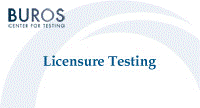Buros-Nebraska Series on Measurement and Testing
Date of this Version
1995
Document Type
Article
Citation
Licensure Testing: Purposes, Procedures, and Practices, ed. James C. Impara (Lincoln, NE: Buros Institute of Mental Measurements, University of Nebraska-Lincoln, 1995).
Abstract
There are a variety of strategies that may be employed in the development of a licensure examination. The following list of activities illustrates typical procedures. Depending on the needs and conditions of the particular occupation, certain variations in specific activities may take place or changes in the sequence may be appropriate. In addition to the procedures listed, many decisions will be made that may add activities. For example, the decision to use a computerized item bank or to enter into a computerized adaptive testing format will require procedures in addition to those described briefly below.
1. Conducting a job (or practice) analysis. Often practitioners in the occupation are surveyed to assess the nature of the job; the essential knowledge, skills, and abilities (KSAs) associated with the job; the extent that the KSAs are critical to performance in the profession for the purpose of protecting the public; and the extent that these critical KSAs are at the entry level of practice. An initial list of KSAs is often developed by a committee (perhaps supplemented by "shadowing" some practitioners and seeking additional insights from interviews with others) and a survey questionnaire is drafted and piloted. The pilot testing leads to expansion and development of the questionnaire that is then sent to a sample of practitioners. Responses may be analyzed by staff or a consultant.
2. Developing test specifications based on the job analysis. The licensure board, or a test committee, determines the specific content dimensions and nature of the test by examining the job analysis (often assisted by quantitative analyses of the survey done by staff or a consultant). It may be possible to obtain a copy of the test specifications (or even the job analysis) of the tests currently being used in the same or related fields in other states or nationally and compare them with each other to assess the essential differences among the occupations of interest.
3. Making a decision about test development. Strategies at this stage include: (a) develop an original test from scratch, (b) use a test already developed by another state or a national organization, or (c) attempt to collaborate with other states to develop a new test. Test development is an arduous and long-term project that has far-reaching implications and costs. If the occupation to be licensed is unique this may be the only available option. If original test development is the decision, the development process could be expected to take up to 2 years and it should be done with the advice of a test specialist/consultant.
Ideally, test development includes such activities as drafting original test items, reviewing the items by a testing committee, revising the items, pilot testing the items, assessing the psychometric properties of the items (DIF analysis) and the total scores (reliability and validity studies), refining the items based on the pilot test results, assembling the items into a final form (and having one or more alternate forms is desirable).
4. Arranging for test administration. The examination must be administered and scored. Various decisions need to be made (e.g., distributing the tests, employing test proctors, insuring test security, compliance with the ADA legislation) before the testing program can become operational.
5. Arranging for test scoring and data analysis. Reports need to be developed for the Board as well as for candidates who were tested. Reports to the Board often include various statistics about the test (e.g., item analyses, DIF analyses, reliability estimates, overall and subgroup score distributions). Examinees will need to know their test results, licensed or not, and the Board may decide to provide some diagnostic feedback to candidates who failed the test.
Included in
Adult and Continuing Education and Teaching Commons, Educational Assessment, Evaluation, and Research Commons, Other Education Commons


Comments
Copyright © 1995 by Buros Institute of Mental Measurements. Digital Edition copyright © 2012 Buros Center for Testing.